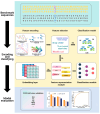Empirical Comparison and Analysis of Artificial Intelligence-Based Methods for Identifying Phosphorylation Sites of SARS-CoV-2 Infection
- PMID: 39769436
- PMCID: PMC11678915
- DOI: 10.3390/ijms252413674
Empirical Comparison and Analysis of Artificial Intelligence-Based Methods for Identifying Phosphorylation Sites of SARS-CoV-2 Infection
Abstract
Severe acute respiratory syndrome coronavirus 2 (SARS-CoV-2) is a member of the large coronavirus family with high infectivity and pathogenicity and is the primary pathogen causing the global pandemic of coronavirus disease 2019 (COVID-19). Phosphorylation is a major type of protein post-translational modification that plays an essential role in the process of SARS-CoV-2-host interactions. The precise identification of phosphorylation sites in host cells infected with SARS-CoV-2 will be of great importance to investigate potential antiviral responses and mechanisms and exploit novel targets for therapeutic development. Numerous computational tools have been developed on the basis of phosphoproteomic data generated by mass spectrometry-based experimental techniques, with which phosphorylation sites can be accurately ascertained across the whole SARS-CoV-2-infected proteomes. In this work, we have comprehensively reviewed several major aspects of the construction strategies and availability of these predictors, including benchmark dataset preparation, feature extraction and refinement methods, machine learning algorithms and deep learning architectures, model evaluation approaches and metrics, and publicly available web servers and packages. We have highlighted and compared the prediction performance of each tool on the independent serine/threonine (S/T) and tyrosine (Y) phosphorylation datasets and discussed the overall limitations of current existing predictors. In summary, this review would provide pertinent insights into the exploitation of new powerful phosphorylation site identification tools, facilitate the localization of more suitable target molecules for experimental verification, and contribute to the development of antiviral therapies.
Keywords: SARS-CoV-2; computation tool; deep learning; machine learning; phosphorylation site.
Conflict of interest statement
The authors declare no potential conflicts of interest.
Figures


Similar articles
-
PhosBERT: A self-supervised learning model for identifying phosphorylation sites in SARS-CoV-2-infected human cells.Methods. 2024 Oct;230:140-146. doi: 10.1016/j.ymeth.2024.08.004. Epub 2024 Aug 22. Methods. 2024. PMID: 39179191
-
Advancing the accuracy of SARS-CoV-2 phosphorylation site detection via meta-learning approach.Brief Bioinform. 2023 Nov 22;25(1):bbad433. doi: 10.1093/bib/bbad433. Brief Bioinform. 2023. PMID: 38058187 Free PMC article.
-
Comparative analysis of machine learning-based approaches for identifying therapeutic peptides targeting SARS-CoV-2.Brief Bioinform. 2022 Jan 17;23(1):bbab412. doi: 10.1093/bib/bbab412. Brief Bioinform. 2022. PMID: 34595489 Free PMC article.
-
Role of biological Data Mining and Machine Learning Techniques in Detecting and Diagnosing the Novel Coronavirus (COVID-19): A Systematic Review.J Med Syst. 2020 May 25;44(7):122. doi: 10.1007/s10916-020-01582-x. J Med Syst. 2020. PMID: 32451808 Free PMC article.
-
Comprehensive analyses of bioinformatics applications in the fight against COVID-19 pandemic.Comput Biol Chem. 2021 Dec;95:107599. doi: 10.1016/j.compbiolchem.2021.107599. Epub 2021 Nov 2. Comput Biol Chem. 2021. PMID: 34773807 Free PMC article. Review.
References
-
- Chen N., Zhou M., Dong X., Qu J., Gong F., Han Y., Qiu Y., Wang J., Liu Y., Wei Y., et al. Epidemiological and clinical characteristics of 99 cases of 2019 novel coronavirus pneumonia in Wuhan, China: A descriptive study. Lancet. 2020;395:507–513. doi: 10.1016/S0140-6736(20)30211-7. - DOI - PMC - PubMed
Publication types
MeSH terms
Substances
Grants and funding
LinkOut - more resources
Full Text Sources
Medical
Miscellaneous

